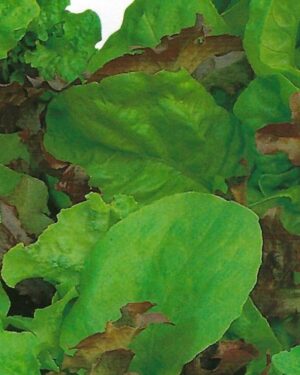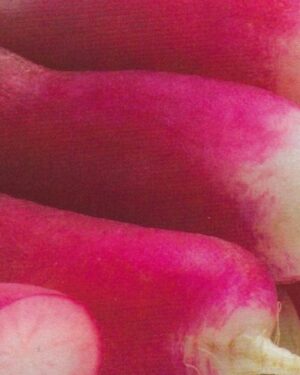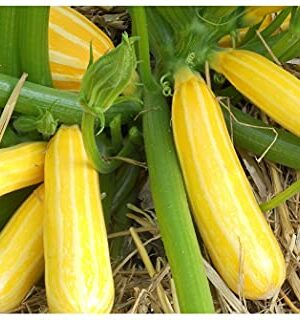Description
CHICORY – ZUCCHERINA DI TRIESTE
CHICORY – ZUCCHERINA DI TRIESTE A sweet baby leaved cutting chicory from Trieste producing heart shaped upright light green leaves with very thin stems and a mild flavour. Fast growing as a cut and come again crop.
Cultivation CHICORY – ZUCCHERINA DI TRIESTE
1. Choose a sunny spot with well-draining soil. Chicory, including Zuccherina di Trieste, prefers fertile, loamy soil. Ensure the soil is rich in organic matter.
2. Sow seeds directly into the ground after the last frost date in your area. Zuccherina di Trieste can be planted in early spring for a late spring/early summer harvest or in late summer for a fall harvest.
3. Plant seeds about 1/4 to 1/2 inch deep in rows spaced around 12 to 18 inches apart. Thin the seedlings to about 6 to 8 inches apart to allow for proper growth.
4. Keep the soil consistently moist but not waterlogged, especially during dry periods. Water deeply and regularly, ensuring the roots receive adequate moisture.
5. Incorporate organic matter or a balanced fertilizer into the soil before planting to provide essential nutrients for the plants.
6. Weed the area regularly to prevent competition for nutrients and space. Mulching can help retain soil moisture and suppress weed growth.
7. Zuccherina di Trieste chicory can be harvested when the heads are mature, typically around 80-90 days after planting. The leaves can be cut at the base or the entire plant can be uprooted.
8. Store harvested chicory heads in a cool, dry place. They can also be stored in the refrigerator for several days.
9. Keep an eye out for common pests like aphids or snails and address any infestations promptly. Chicory is generally resistant to diseases, but good air circulation can prevent issues like fungal infections.
10. To extend your harvest, consider planting Zuccherina di Trieste in succession, staggering plantings every few weeks.
11. Zuccherina di Trieste chicory prefers cooler temperatures. In warmer regions, planting in late summer for a fall harvest might be more successful as chicory tends to bolt (go to seed) in response to heat. For cooler climates, planting in early spring is ideal.
12. Chicory generally prefers a slightly acidic to neutral soil pH (around 6.0 to 7.0). Test your soil and adjust pH levels if needed to optimize growth.
13. Some gardeners blanch chicory to reduce bitterness and improve tenderness. Blanching involves covering the growing plants or specific leaves to exclude light. This can be achieved by wrapping the plants with paper or tying the outer leaves together, restricting sunlight from reaching the inner leaves.
14. Consistent moisture is crucial, especially during the germination and initial growth stages. Avoid overwatering, which can lead to root rot, but ensure the soil remains consistently moist.
15. If there’s a sudden cold snap or unexpected frost, covering the plants with row covers or providing other forms of protection can help prevent damage to the leaves.
16. If you intend to save seeds for the next planting season, allow some plants to bolt and produce flowers. Once the flowers have dried and formed seed heads, collect the seeds and store them in a cool, dry place.
17. Zuccherina di Trieste chicory can be used similarly to other chicory varieties. Experiment with incorporating it into salads, sautés, or even grilling it for a slightly smoky flavor. Consider pairing it with sweet or tangy dressings to balance its natural bitterness.
18. Chicory, including Zuccherina di Trieste, is a good companion for many garden plants, particularly beans, peas, and brassicas. Practice crop rotation to prevent soil depletion and reduce the risk of pests and diseases.
19. Consider using mulch around the plants to regulate soil temperature, retain moisture, and inhibit weed growth. Organic mulches, such as straw or compost, work well and contribute nutrients as they break down.
20. Adequate spacing and thinning are crucial for healthy plant growth. If seedlings are overcrowded, thin them out to the recommended spacing to allow proper airflow and light penetration.
21. In colder climates, consider using frost cloth or row covers to protect the plants from freezing temperatures, especially during late fall or early spring when frost is still a risk.
22. Chicory, like most leafy greens, benefits from regular fertilization. Consider applying a balanced fertilizer or compost tea every few weeks to ensure steady growth and healthy leaf production.
23. To encourage continuous growth, harvest outer leaves as needed rather than taking the entire plant at once. This allows the inner leaves to continue developing.
24. Chicory can be grown alongside various plants like radishes, carrots, and onions, which may help deter pests and make efficient use of space.
25. While chicory is generally resistant to diseases, maintaining good air circulation by proper spacing and avoiding overhead watering can minimize the risk of fungal diseases.
26. Taste preferences for chicory’s bitterness vary. Some gardeners enjoy the slight bitterness, while others prefer milder flavors. Experiment with different growing conditions and harvesting times to find the taste that suits your palate.
27. Observing how Zuccherina di Trieste responds to your local climate is key. Adjust planting times or growing methods based on your region’s unique weather patterns for optimal growth.









Reviews
There are no reviews yet.